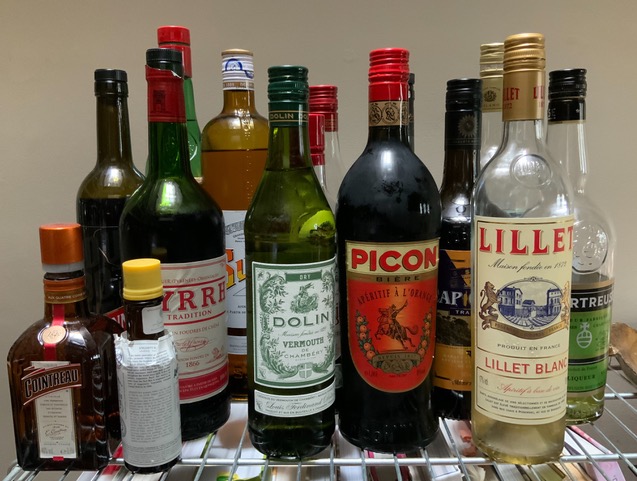Underrated, undiscovered, unappreciated no more. French drinkers are rediscovering and appreciating their drinking heritage. Traditional liqueurs, “forgotten” French spirits, are being taken out of the cupboards, dusted off and shaken back into life.
Many of these legendary vintage spirits and liqueurs are produced by companies whose stories go back decades and even centuries. Each has a unique and authentic heritage, often with layers of regional individuality and proven quality and flavor.
Although today you will find many of these liqueurs being blended into cocktails, originally, they were consumed as standalone drinks, a predinner tipple to whet the appetite or a digestif to finish off the evening.
Here are two of my favorites.
Dubonnet
This aperitif falls into the category of quinquinas, so named because they contain quinine, the bitter active ingredient in cinchona bark, once used to prevent and cure malaria. Quinine was an invaluable medicine during the European colonial period when troops were sent out to build empires in the most inhospitable and malaria-ridden corners of the world. While effective, quinine is rather foul-tasting so in the 1830’s the French government launched an appeal for a product that could make it more palatable in order to coax the troops into taking it.
Parisian chemist Joseph Dubonnet was first off the mark, adding quinine to fortified wine. Originally called “quinquina Dubonnet,” the remedy wine proved to be very popular among the French soldiers abroad, so much so that they continued to drink it when they returned home. By the 1900’s, Dubonnet was the “aperitif du jour,” popular not only in cafés and bistros throughout France but also across the channel, especially with the late Queen Mother who liked to mix it with equal parts gin.
Dubonnet has a dark burgundy color and a light fruitiness with notes of woody spice, blackberry, chocolate and, of course, that magic, medicinal quinine. Its low abv (15%) makes it a modest predinner apéritif. Dubonnet also exists in white and amber, but they are not as worthy as the red.
Other popular quinquinas are Lillet, Americ Picon and Byrrh, among others.
I like to drink Dubonnet straight, cold from the fridge, but it can also be served over ice, with tonic or soda, and is a great partner with gin. The craft cocktail movement has increased the visibility and availability of Dubonnet, and these days you can find hip bartenders mixing it into all sorts of cocktails like the one below.
Alfonso
A popular cocktail at the Le Mary Celeste in the 3rd arrondissement in Paris.
1 sugar cube
3 dashes Angostura bitters
1 ounce chilled Dubonnet Rouge
Dry Champagne
Lemon peel
Place the sugar cube in a wine glass and dash with the Angostura bitters. Pour in the Dubonnet and top up with champagne. Garnish with lemon twist.
*recipe adapted from Apératif, Cocktail Hour the French Way by Rebekah Peppler
Suze
This bitter-sweet, sunny yellow-orange apéritif in a beautiful art deco bottle is part of the family of liqueurs known as Americanos, which includes old favorites like Salers, Campari and Aperol. What these drinks have in common is that, while they may contain quinine, most of their bitterness comes from the root of the Gentian plant, a long wildflower traditionally grown in the mountainous Alpine landscapes between France and Switzerland. (The Americano is also, confusingly, a cocktail.)
To make it, the yellow and blue blossomed gentian plants are harvested for their gnarled roots, which are then washed, chopped into thin strips and left to macerate in alcohol for at least a year. Next, the juice is distilled and blended with a secret aromatic bouquet, known only as “angelica,” which gives Suze its distinctively strong flavor and just the right amount of sweetness to balance the bracing bitterness.
Suze has been around since 1885, and until recently was probably best remembered as a French grandmother’s favorite drink or for being the subject of Picasso’s painting in 1912, Verre et Bouteille de Suze (Glass and Bottle of Suze). But thanks to the revival of old aperitifs, Suze is experiencing a second life and has become the must-have drink on any respectable French cocktail list.
To be sure, Suze is an acquired taste, but it can be extremely refreshing to sip on a warm day. On their own, gentian-based aperitifs can be quite strong, so they are usually diluted with water or when served neat, given a twist of lemon or another citrus fruit. The French like to keep it simple and drink Suze with one ice cube in a glass. To give Suze a lighter, brighter touch, make a Suze spritz (with 3 parts sparkling wine, 2 parts Suze and 1 splash soda) or mix it into a cocktail with a little Lillet blanc.
Triple Ménace
There is nothing threatening about this drink.
Makes 1 serving:
1 ounce London dry gin
1 ounce Lillet blanc
½ ounce Suze
½ ounce fresh lemon juice
Pour the gin, Lillet, Suze and lemon into a cocktail mixing glass. Fill with ice and stir until chilled. Strain into a tumbler and add 1 or 2 ice cubes and more fresh lemon juice if you like.
*recipe adapted from Drinking French by David Lebovitz
Charlotte Puckette is a Grand Diplôme graduate of Paris’s Le Cordon Bleu, co-author of The Ethnic Paris Cookbook, as well as a private chef, caterer, cooking instructor, food consultant, and hostess.


